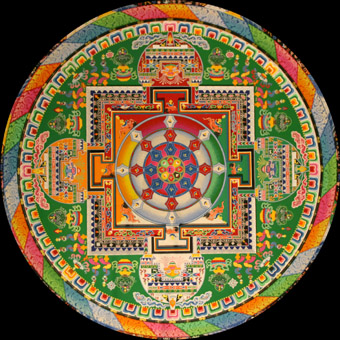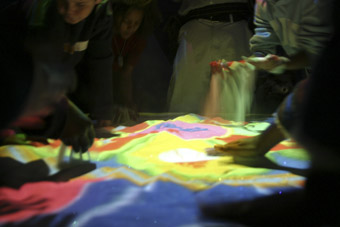infinities material and spiritual
urszula dawkins: vesna & gimzewski’s nanomandala

Nanomandala, Victoria Vesna, James Gimzewski
courtesy the artists
Nanomandala, Victoria Vesna, James Gimzewski
IN A BLACKED-OUT ROOM, AS PART OF JOHN CURTIN GALLERY’S ART IN THE AGE OF NANOTECHNOLOGY EXHIBITION, THE TIBETAN BUDDHIST SAND MANDALA OF CHAKRASAMVARA GLOWS IN SATURATED COLOURS, PROJECTED FROM ABOVE ONTO A TWO-METRE DIAMETER SANDPIT.
The intricately rendered geometric patterns, human figures, tiny creatures and curling clouds are readable in their entirety for just a few seconds before the image zooms back towards the grains of sand from which the original mandala is constructed.
Quickly the detail recedes into areas of bright colour, localising towards the centre of the mandala, and soon we are looking at ever-growing grains of brightly coloured sand, filling more and more of the circular field of vision. They morph into a micro-landscape of boulders and edges before the rich hues fade and we begin to ‘see’ at the nano-level—a scale at which colour itself ceases to exist and the sandscape becomes flakes and mounds of rippled grey and white. From here begins the slow, meditative return to the macro scale: the looped projection is a 15-minute journey from the visible to the unimaginable and back, across a realm encompassing aesthetic, scientific and spiritual dimensions.
Artist Victoria Vesna and scientist James Gimzewski have collaborated on several projects involving nanotechnology, a field that extends what is ‘seen’ to its outer limits, using instruments that don’t photograph but gather physical data by ‘touching’ molecular surfaces—data that is algorithmically interpreted to produce visual images. Four monks from the Tibetan Gaden Lhopa Khangtsen monastery in India worked full time for a month to create the original mandala for the Los Angeles County Museum of Art. Vesna and Gimzewski then photographed it at a range of scales from wide-angle to macro lens. The mandala’s central motif was recreated in the laboratory, where it was imaged firstly with an optical microscope and then a Scanning Electron Microscope. To create a seamless video projection that would zoom down to the nanoscale took 300,000 individual frames—around 900GB of data. Rendering the final composition took 36 computers two full days to complete.

Nanomandala, Victoria Vesna, James Gimzewski
courtesy the artists
Nanomandala, Victoria Vesna, James Gimzewski
The intensity of the lab-work resonates with the Buddhist practice of creating the mandala: a process involving extreme finesse and patience in which finely corrugated, sand-filled cones are gently rubbed so that grain-by-grain the image is built into being. The link is not arbitrary: Vesna’s relationship with Tibetan Buddhism goes back to her college days, when she first read Robert Thurman’s translation of the Tibetan Book of the Dead. “Buddhism and meditation were always informing my practice,” says Vesna, “and to be participating in the creation of the Chakrasamvara was a great teaching and transmission for me.”
The themes of life, death and transition seem to lend themselves to an artistic engagement with nanotechnology: other works in the Art in the Age of Nanotechnology exhibition explore these themes in several ways, creating human interactions at the borderline between the known and the unknowable of objects that are measured in billionths of metres.
The creation of Nanomandala in 2003, says Vesna, has influenced her subsequent work (see Blue Morph or Quantum Tunnel, also collaborations with Gimzewski) both in terms of its interactivity and the sense that the artwork is “manifested” rather than directed, with a specific energy and path of its own. At face value, the ‘interactivity’ of Nanomandala is limited—viewers can sculpt the sand while the image creeps across it, or sift it through their fingers—but in the context of the scale and delicacy of Nanomandala, this seems an almost clumsy interaction with a work that otherwise operates at high precision and high resolution. Watching the entire 15-minute loop, however, is a commitment to a kind of meditation and exchange; and this meditative interaction seems much more to the point.
Nanomandala’s aural component, by sound artist Anne Niemetz, runs parallel in scale to the shifting images: a collage that by turns includes the deep, harmonics-soaked throat-singing of the Tibetan meditation chant and the highly amplified sounds of the monks’ sand-sculpting tools—vibrating, cricket-like rubs and taps that accompany the image as it approaches nano-scale.
The sheer, vivid beauty of Nanomandala—though Vesna points out that terror is equally a part of the mandala image—sets it apart from the other works in this exhibition, as does an engagement with the spiritual that does not look to conceptualism for its validity. Despite both an immense degree of technical production, and its strong engagement with Tibetan Buddhist practice, Nanomandala has an aesthetic simplicity and spaciousness that leaves abundant room for individual response and contemplation.
Perth International Arts Festival: Victoria Vesna and James Gimzewski, Nanomandala (2003), exhibited in Art in the Age of Nanotechnology, John Curtin Gallery, Curtin University of Technology, Perth, Feb 5-April 30
Read about other works in this exhibition here.
RealTime issue #96 April-May 2010 pg. 23






